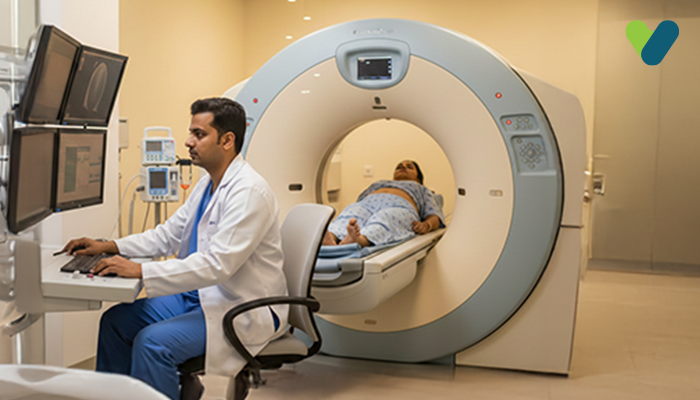The scrotum is the skin pouch situated at the base of the penis and has the testicles inside it. The organs of the reproductive system of males that generate sperm as well as the hormone testosterone are referred to as the testicles. They are found in the scrotum, in addition to other small organs, the vas deferens, a small tube, and blood vessels. This page will discuss the scrotal ultrasound, why it is done, how to prepare for the ultrasound, and what happens during the ultrasound.
What is a scrotal ultrasound?
A scrotal ultrasound scan, also known as a testicular ultrasound scan, uses sound waves to create the pictures of the scrotum, especially the testicles. Sound waves are sent into the scrotum by an ultrasound machine, and the pictures are visualised on a computer.Why are scrotal scans performed?
When doctors are concerned about symptoms like scrotal swelling or pain, they will order a scrotal ultrasound.A scrotal ultrasound scan can reveal:
- Signs of testicular injury
- Testicles size
- Scrotal veins that are unusually swollen (varicocele)
- Inflammation or infection of the testicle (orchitis) or epididymis (epididymitis)
- Fluid accumulation around the testicle (hydrocele)
- A scrotal cyst or tumour
- An undescended or absent testicle
- Testicular twisting (testicular torsion)
- Infertility
How to prepare for a testicular/scrotal ultrasound
No special preparations are needed for the scan. It is not necessary to abstain from eating or drinking anything prior to the appointment. Before the exam, a patient needs to remove all garments below the waist. The patient may prefer wearing something easy to remove.Be prepared to remain as still as doable during the ultrasound procedure in order for the ultrasound equipment to produce clear pictures of the testicles. Medication can rarely be interrupted or stopped prior to a testicular ultrasound. You should, however, consult your doctor for advice on any over-the-counter or prescription medications you use.
What to expect during the scrotal ultrasound?
The procedure will take place in your doctor's office, clinic, or radiology department. It is pain-free and takes about 30 minutes.You will need to lie flat on the back on the examination table. A water-based gel will be applied to your scrotum by an ultrasound technician. They will move a small tool across your skin (called a transducer) against your scrotum. It does not hurt, but you might feel some pressure.
Sound waves travel from your skin to the transducer. The photos of the testicles will be displayed on the computer monitor. After the ultrasound, the gel will be wiped off, and the photos will be reviewed by a radiologist.

